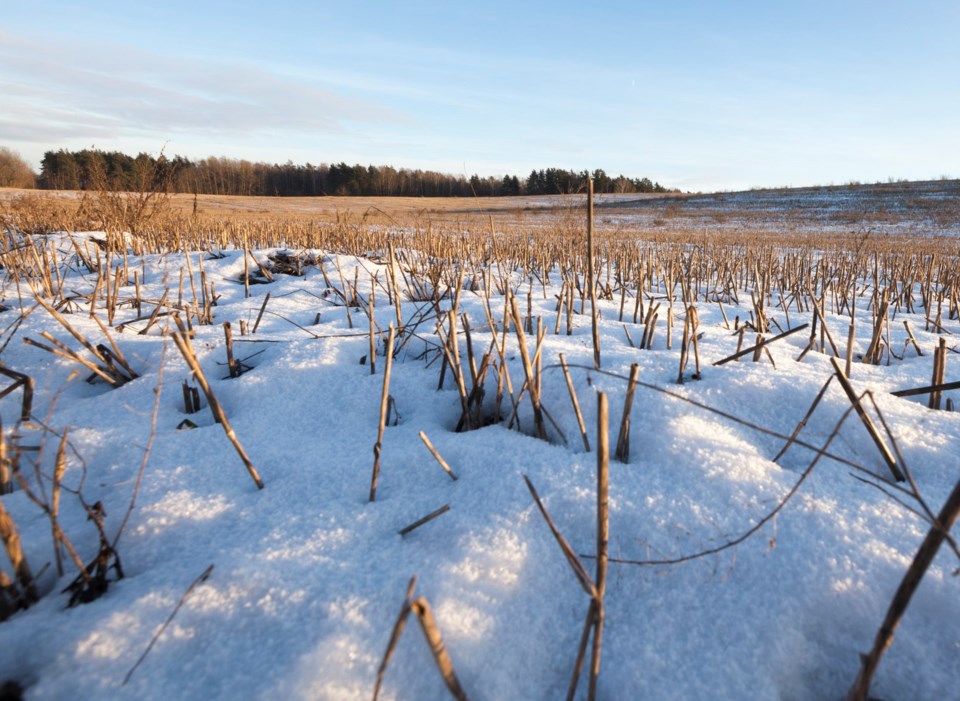WESTERN PRODUCER — Of all the inputs required to grow a crop on the Canadian Prairies, water is among the most important, the most scarce and the most difficult to manage.
However, there are steps grain growers can take to increase water availability, says researcher and long-time wheat breeder Ron DePauw.
It starts with managing stubble and conserving moisture resources, including winter snowfall.
“Whatever a farmer can do in his production practices to trap the snow on his land, that will be a huge boost to getting next year’s crop emerging and established,” said DePauw.
In an interview, DePauw encouraged growers to think about stubble management when planting and harvesting this year’s crop.
Leaving higher stubble at harvest time will trap more snow, providing additional soil moisture for subsequent crops in the rotation.
Phillip Harder, a research associate and hydrology expert at the University of Saskatchewan, said growers can reduce spring-time runoff and evaporation-related losses by maintaining healthy levels of crop residue on the soil surface.
According to research, a one centimetre increase in stubble height will add the equivalent of one millimetre of additional soil moisture in an average production year. A 10 percent increase in crop residue on the soil surface will result in a five percent decrease in soil moisture evaporation.
Evaporative losses are typically higher in fields where plant densities fall below recommended levels. This is particularly true in the spring when a larger proportion of the soil surface is exposed to sun and wind.
Because of this, growers should consider their seeding rates carefully and take the necessary steps to maintain healthy plant populations.
Harder also encouraged growers to pay close attention to residue management.
The use of stripper headers can be particularly beneficial in areas where soil moisture reserves are limited.
“From a hydrology perspective, we always want to think about the water balance,” Harder said during a recent SaskWheat podcast.
In other words, keep track of what’s coming in and what’s going out.
“There’s all sorts of new opportunities these days to manage our residues and our stubbles in ways that we never have in the past.”
Saskatchewan crops depend largely on in-season rainfall for grain production.
However, stubble and residue management strategies that focus on soil moisture recharge can make a significant difference in overall productivity.
In 2017, data from Kenaston, Sask., suggested that canola crops that required a total of 250 millimetres of water between planting and harvest acquired 183 mm from existing soil moisture reserves and only 67 mm from in-season rainfall.
“So in that situation, 75 percent of our crop water use was coming from sources other than rainfall,” Harder said.
DePauw said farmers can also use other strategies to get more productivity out of every precious drop of moisture.
He said wheat producers should pay close attention to the varieties they sow because some varieties are much more adept at converting moisture into harvested grain yield.
Provincial seed guides, which assess and compare the performance of different wheat varieties across different regions, are a valuable source of information when selecting a variety.
In general, wheat varieties that produce a relatively high yield over a longer period of time will indicate a variety with greater plasticity. The plasticity of a variety indicates its ability to produce high yields over a variety of environmental conditions.
Because growers cannot anticipate the growing conditions in any given crop cycle with certainty, selecting a variety with high plasticity will ensure a relatively productive outcome, regardless of the growing conditions.
DePauw said it’s no coincidence that Canadian Western red spring wheat varieties such as AAC Brandon, AAC Starbuck and AAC Viewfield have enjoyed rapid uptake among western growers.
They offer better plasticity relative to older varieties and have produced well under dry conditions, under wet conditions and under highly variable conditions.
Comparative yield data over the past five years, for example, may give insight to growers who are worried about continued dry conditions.
By comparing yield data collected during consecutive growing seasons affected by drought, growers may be able to gain further insight into what wheat varieties offer greater water use efficiency.




